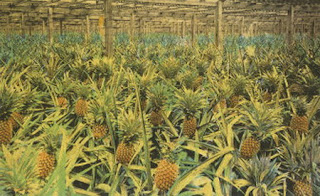Pineapple | Agriculture | Pineapple is the common name for low-growing, fruit-bearing, tropical plants of the species Ananas comosus (also known as Ananas sativus) in the bromeliad family (Bromeliaceae). It is also the name for the large, edible, multiple fruit of this plant. Ananas comosus has long, swordlike leaves and the fleshy fruit has a tuft of leaves on one end as well. It is native to Central and South America, but has been introduced elsewhere, including Hawaii, which now is a main commercial producer of the fruit (Herbst, 2001).
In addition to serving as food, with its natural sweetness, the pineapple has served in history as a symbol and an artistic motif. According to Levins (2004), the rarity, reputation, expense, and visual attractiveness of the pineapple made it an item of celebrity and the "ultimate exotic fruit." The pineapple was so coveted and uncommon that in the 1600s King Charles II of England posed receiving a pineapple as a gift in an official portrait. In colonial America, the pineapple became a symbol of hospitality, and served as the pinnacle of an entertaining household's feast, even being rented to households during the day for display on the table and then sold to more affluent clients who actually ate it (Levins, 2004). As a symbol of hospitality and friendship, the pineapple became a favorite motif of architects, artisans, and craftsman in the American colonies, and would be seen on the main gate posts of mansions, in the weather vanes of public buildings, and on walls, canvas mats, tablecloths, napkins, the backs of chairs, in china, and so forth (Levins, 2004).
Pineapple can be consumed fresh, canned or juiced and can be used in a variety of ways. It is popularly used in desserts, salads (usually tropical fruit salads, but it can vary), jams, yogurts, ice creams, various candies, as a complement to meat dishes and in fruit cocktail. The popularity of the pineapple is due to its sweet-sour taste. The core of the pineapple is continuous with the stem supporting the fruit and with the crown, a feature unique among cultivated fruits.
In addition to the hospitality and friendship symbolism of a bygone era, the pineapple reflects the harmony in nature, as it provides food for hummingbirds and in turn is pollinated by the birds.
Pineapple is used for many other things aside from consumption. In the Philippines, pineapple leaves are used as the source of a textile fiber called piña. This fiber can used in a variety of ways such as a wall paper and a component of furnishings.
Ananas comosus is an herbaceous perennial plant, 1–1.5 meters tall, with 30 or more trough-shaped and pointed leaves, 30–100 cm long, surrounding a thick stem. Among common cultivars, the leaves of the Smooth Cayenne cultivar mostly lack spines except at the leaf tip, but the Spanish and Queen cultivars have large spines along the leaf margins.
Pineapples are the only bromeliad fruit in widespread cultivation. The pineapple is a multiple fruit, meaning it is formed from a cluster of flowers (called an inflorescence) growing on a catkin, with each flower on the catkin producing a fruit and the entire cluster maturing into a single mass—the pineapple. The fruitlets of a pineapple are arranged in two interlocking spirals, eight spirals in one direction, thirteen in the other; each being a Fibonacci number. This is one of many examples of Fibonacci numbers appearing in nature.
The natural pollinator of the pineapple is the hummingbird. Pollination is required for seed formation; the presence of seeds negatively affects the quality of the fruit. In Hawaii, where pineapple is cultivated on an agricultural scale, importation of hummingbirds is prohibited for this reason.
Certain bat-pollinated wild pineapples do the exact opposite of most flowers by opening their flowers at night and closing them during the day; this protects them from weevils, which are most active during daylight hours. - AGRICULTURE
Pineapple







Share and socialize your blog post on www.nolsense.com. New dofollow news/social bookmarking site.Get easy backlinks.
ReplyDelete